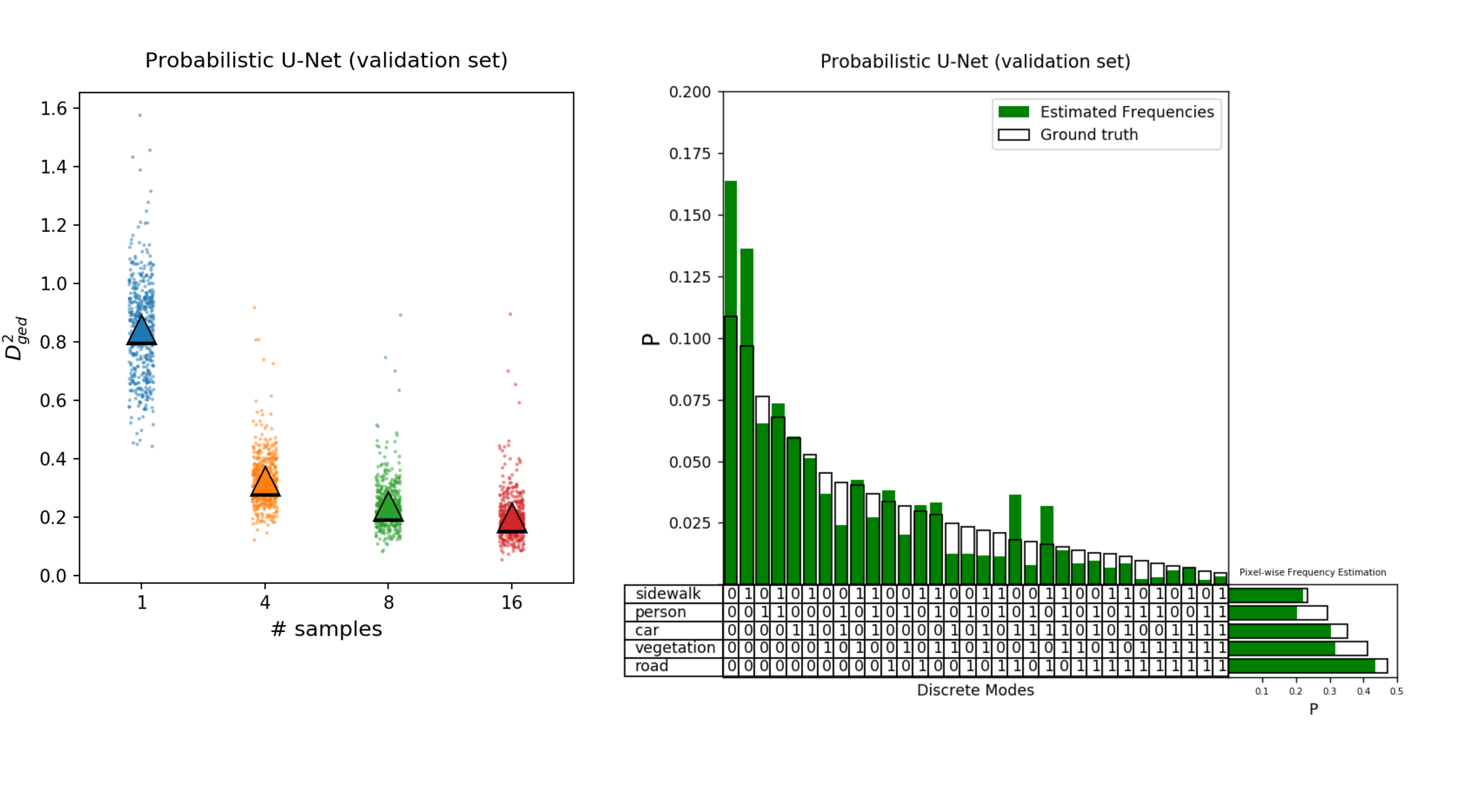SimonKohl / Probabilistic_unet
Projects that are alternatives of or similar to Probabilistic unet
Probabilistic U-Net
+ **Update**
+ An improved Model (the Hierarchical Probabilistic U-Net) + LIDC crops is now available. See below.
Re-implementation of the model described in `A Probabilistic U-Net for Segmentation of Ambiguous Images' (paper @ NeurIPS 2018).
This was also a spotlight presentation at NeurIPS and a short video on the paper of similar content can be found here (4min).
The architecture of the Probabilistic U-Net is depicted below: subfigure a) shows sampling and b) the training setup:

Below see samples conditioned on held-out validation set images from the (stochastic) CityScapes data set:

Setup package in virtual environment
git clone https://github.com/SimonKohl/probabilistic_unet.git .
cd prob_unet/
virtualenv -p python3 venv
source venv/bin/activate
pip3 install -e .
Install batch-generators for data augmentation
cd ..
git clone https://github.com/MIC-DKFZ/batchgenerators
cd batchgenerators
pip3 install nilearn scikit-image nibabel
pip3 install -e .
cd prob_unet
Download & preprocess the Cityscapes dataset
- Create a login account on the Cityscapes website: https://www.cityscapes-dataset.com/
- Once you've logged in, download the train, val and test annotations and images:
- Annotations: gtFine_trainvaltest.zip (241MB)
- Images: leftImg8bit_trainvaltest.zip (11GB)
- unzip the data (unzip _trainvaltest.zip) and adjust
raw_data_dir(full path to unzipped files) andout_dir(full path to desired output directory) inpreprocessing_config.py - bilinearly rescale the data to a resolution of 256 x 512 and save as numpy arrays by running
cd cityscapes
python3 preprocessing.py
cd ..
Training
[skip to evaluation in case you only want to use the pretrained model.]
modify data_dir and exp_dir in scripts/prob_unet_config.py then:
cd training
python3 train_prob_unet.py --config prob_unet_config.py
Evaluation
Load your own trained model or use a pretrained model. A set of pretrained weights can be downloaded from zenodo.org (187MB). After down-loading, unpack the file via
tar -xvzf pretrained_weights.tar.gz, e.g. in /model. In either case (using your own or the pretrained model), modify the data_dir and
exp_dir in evaluation/cityscapes_eval_config.py to match you paths.
then first write samples (defaults to 16 segmentation samples for each of the 500 validation images):
cd ../evaluation
python3 eval_cityscapes.py --write_samples
followed by their evaluation (which is multi-threaded and thus reasonably fast):
python3 eval_cityscapes.py --eval_samples
The evaluation produces a dictionary holding the results. These can be visualized by launching an ipython notbook:
jupyter notebook evaluation_plots.ipynb
The following results are obtained from the pretrained model using above notebook:

Tests
The evaluation metrics are under test-coverage. Run the tests as follows:
cd ../tests/evaluation
python3 -m pytest eval_tests.py
Deviations from original work
The code found in this repository was not used in the original paper and slight modifications apply:
- training on a single gpu (Titan Xp) instead of distributed training, which is not supported in this implementation
- average-pooling rather than bilinear interpolation is used for down-sampling operations in the model
- the number of conv kernels is kept constant after the 3rd scale as opposed to strictly doubling it after each scale (for reduction of memory footprint)
- HeNormal weight initialization worked better than a orthogonal weight initialization
How to cite this code
Please cite the original publication:
@article{kohl2018probabilistic,
title={A Probabilistic U-Net for Segmentation of Ambiguous Images},
author={Kohl, Simon AA and Romera-Paredes, Bernardino and Meyer, Clemens and De Fauw, Jeffrey and Ledsam, Joseph R and Maier-Hein, Klaus H and Eslami, SM and Rezende, Danilo Jimenez and Ronneberger, Olaf},
journal={arXiv preprint arXiv:1806.05034},
year={2018}
}
License
The code is published under the Apache License Version 2.0.
Update: The Hierarchical Probabilistic U-Net + LIDC crops
We published an improved model, the Hierarchical Probabilistic U-Net at the Medical Imaging meets Neurips Workshop 2019.
The paper is available from arXiv under A Hierarchical Probabilistic U-Net for Modeling Multi-Scale Ambiguities, May 2019.
The model code is freely available from DeepMind's github repo, see here: code link.
The LIDC data can be downloaded as pngs, cropped to size 180 x 180 from Google Cloud Storage, see here: data link.
A pretrained model can be readily applied to the data using the following Google Colab: .
